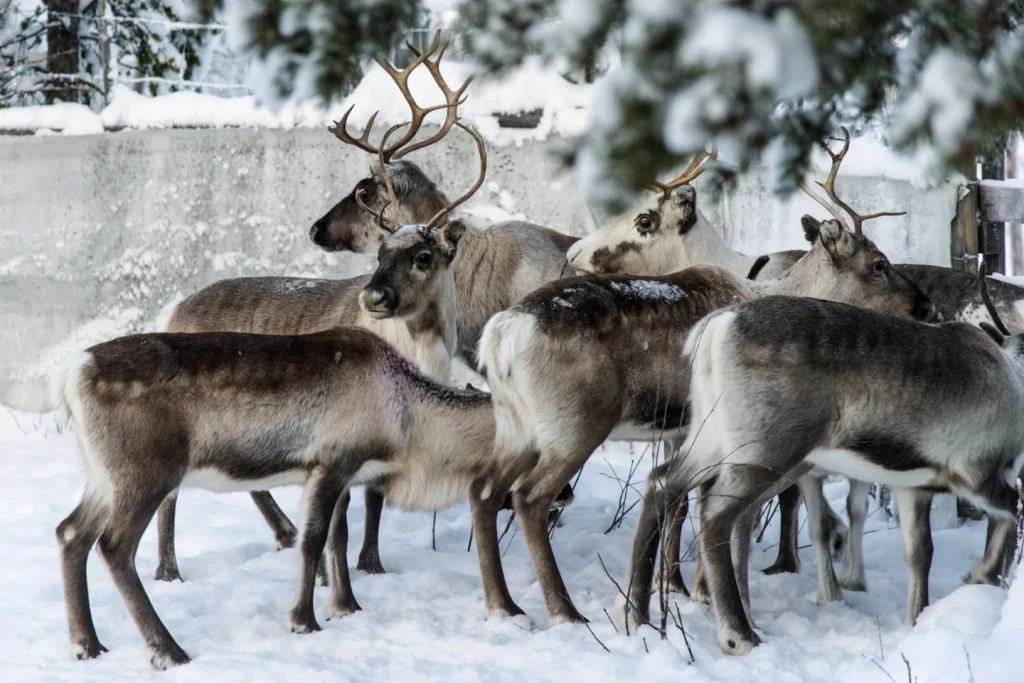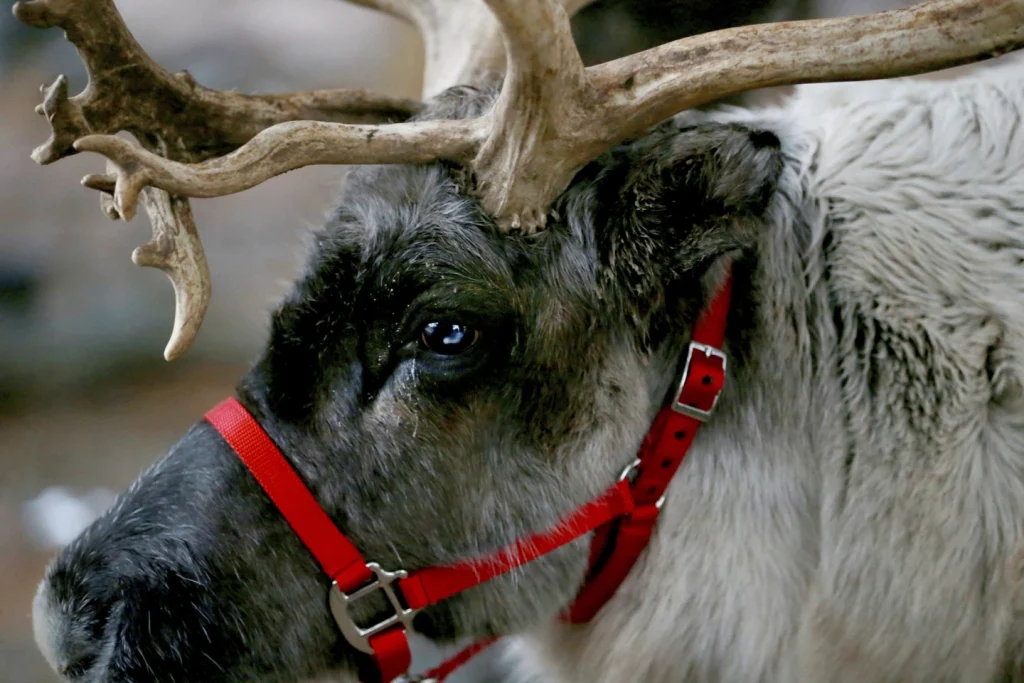In the frigid, desolate landscape of the Arctic, finding sustenance can be an arduous task. However, researchers from Dartmouth College in New Hampshire and the University of St.
Andrews in Scotland have shed light on a remarkable adaptation that has allowed reindeer to thrive in such harsh conditions.
Their recent study, published in the journal i-Perception, reveals that reindeer eyes may have evolved to enable them to easily spot their preferred food source, providing further evidence of the remarkable visual abilities of these iconic animals.
While Rudolph the red-nosed reindeer may be immortalized in holiday lore, it is the unique visual system of reindeer that truly sets them apart.
Nathaniel Dominy, a Dartmouth anthropology professor and co-author of the study, emphasizes the significance of this discovery, stating that reindeer have been overlooked in the field of visual neuroscience despite possessing a truly fascinating visual system.
With their moment in the spotlight, reindeer are finally receiving the recognition they deserve for their remarkable evolutionary adaptation.
The ability of reindeer to navigate the harsh Arctic landscape and locate their preferred food source is a testament to the remarkable ways in which species have adapted to their environments.
In a world where survival often hinges on the ability to secure nourishment, the evolution of specialized visual systems such as those found in reindeer is a captivating area of study that offers valuable insights into the intricacies of natural selection and adaptation.
The findings of the study not only provide a deeper understanding of reindeer physiology and behavior but also have broader implications for the field of evolutionary biology and ecology.
By unraveling the mysteries of reindeer vision, researchers are uncovering valuable insights into the ways in which animals have adapted to thrive in their respective habitats, offering a glimpse into the intricate web of life on our planet.
Furthermore, the study serves as a reminder of the importance of preserving and protecting the natural world.
As we gain a deeper understanding of the remarkable adaptations that allow species like reindeer to survive and thrive, we are reminded of the need to safeguard the environments in which they have evolved.
The Arctic, with its unique and fragile ecosystem, is home to a diverse array of species that have developed specialized adaptations to endure its extreme conditions.
By recognizing the significance of these adaptations, we are compelled to take action to ensure the continued existence of these remarkable creatures and the habitats that sustain them.
In conclusion, the recent study on the evolution of reindeer vision offers a fascinating glimpse into the remarkable adaptations that have allowed these iconic animals to thrive in the harsh Arctic landscape.
By shedding light on the unique visual system of reindeer, researchers have not only deepened our understanding of these captivating creatures but have also provided valuable insights into the broader fields of evolutionary biology and ecology.
As we continue to unravel the mysteries of the natural world, we are reminded of the importance of preserving and protecting the environments that sustain the diverse array of life on our planet.
The unique visual capabilities of reindeer have long been a subject of fascination for scientists. The ability of their eyes to change color from a greenish gold in the summer to a vivid blue in the winter has been known for years, but the recent discovery that reindeer can see light in the ultraviolet spectrum has opened up a new realm of inquiry into their visual perception.
This phenomenon has sparked a debate among researchers about the evolutionary purpose of this unique ability, with some suggesting that it may have evolved as a defense mechanism against predators, while others propose that it may be linked to their foraging habits.
The ability to see ultraviolet light is a rare trait among mammals, as most animals actively avoid UV light due to its damaging effects.
However, for reindeer, this ability may have significant advantages, particularly in their snowy, polar habitats.
Snow reflects UV light, which can be harmful to most animals, leading to conditions such as snow blindness in humans. Yet, for reindeer, this unique visual capability may provide them with a distinct advantage in their environment.
One of the proposed theories for the evolution of this ability is its potential role in foraging. Reindeer primarily subsist on light-colored reindeer moss, a type of lichen that grows abundantly in northern latitudes.
The new study suggests that reindeer moss absorbs UV light, making it stand out as dark patches against the snow, which is advantageous for the animals.
This allows reindeer to easily spot and access their primary food source, conserving energy and ensuring their survival in the harsh winter conditions.
The implications of this discovery are significant, as it sheds light on the intricate relationship between reindeer and their environment.
The ability to see UV light may have played a crucial role in the evolutionary adaptation of reindeer to their snowy habitats, providing them with a competitive edge in foraging for food.
This insight not only enhances our understanding of reindeer biology but also has broader implications for the study of evolutionary ecology and conservation biology.
The research conducted in the Scottish Highlands, where researchers observed the interaction between reindeer and their primary food source, provides valuable insights into the intricate ecological dynamics at play in these environments.
By studying the behavior and visual capabilities of reindeer in their natural habitat, scientists can gain a deeper understanding of the evolutionary forces that have shaped these animals over time.
While the focus of the study was on reindeer, the implications of this research extend beyond the specific species. Juan Jose Negro, a specialist in evolutionary ecology and conservation biology, highlighted the broader significance of this research.
As an expert in birds of prey, he found the findings of the reindeer study to be intriguing, indicating the potential for cross-species insights and applications in the field of evolutionary biology.
In conclusion, the recent discovery of reindeer’s ability to see light in the ultraviolet spectrum has opened up new avenues of research into the evolutionary adaptations of these fascinating animals.
The intricate interplay between their unique visual capabilities and their foraging habits provides valuable insights into the complex relationship between reindeer and their environment.
This research not only enhances our understanding of reindeer biology but also has broader implications for the study of evolutionary ecology and conservation biology.
As scientists continue to unravel the mysteries of reindeer vision, the implications of this research may extend to other species and ecosystems, enriching our understanding of the natural world.
The research conducted by scientists in the Cairngorms mountains in the Scottish Highlands is fascinating and sheds light on how animals adapt to their environments.
The discovery that reindeer moss absorbs UV light and appears as dark patches to the animals is particularly interesting, as it demonstrates how reindeer are able to find food in the snowy landscape.
This is important because it allows the animals to conserve energy and avoid wandering around in search of food.
Juan Jose Negro, an expert in evolutionary ecology and conservation biology, finds this research intriguing and believes that it could lead to new ideas about how animals perceive colors and vision.
Although he does not see any immediate biomedical applications of this research, he believes that it is useful in furthering our understanding of how animals cope with difficult environments.
Similarly, Nathaniel Dominy, who conducted the reindeer research, agrees that this work has human implications.
Lichens have antioxidant properties and are therefore the subject of pharmacological research. The fact that reindeer eyes allow in UV light suggests that there may be a mechanism in place to protect them from damage.

Dominy notes that reindeer eyes are full of ascorbic acid, or vitamin C, which is known to repair damaged cells. This suggests that vitamin C-rich foods such as orange juice and carrots could be beneficial for the health of reindeer eyes.
In light of this research, Dominy is updating his advice from a 2015 paper about why a reindeer’s red nose is ideal for guiding Santa’s sleigh.
He now recommends that children focus on providing reindeer with vitamin C-rich treats rather than high-calorie foods to protect their eyes.
This is a valuable insight that could have implications for the health and wellbeing of reindeer in the wild.
Overall, this research highlights the importance of understanding how animals adapt to their environments and how this can have implications for human health.
It is a fascinating area of study that could lead to new insights into the ways in which we can protect and preserve the natural world.
